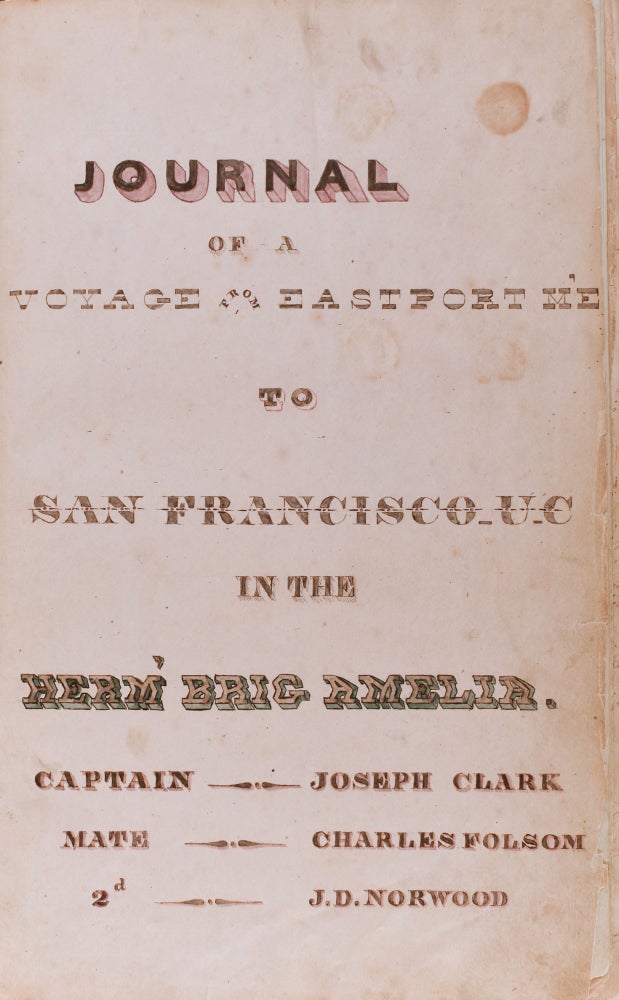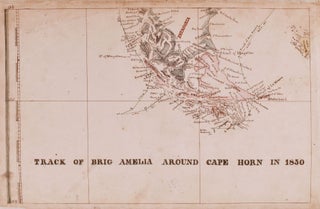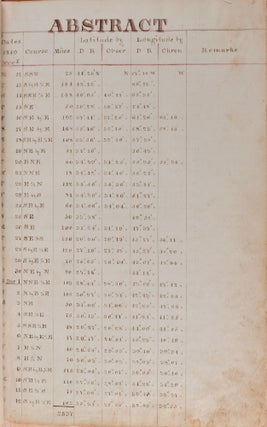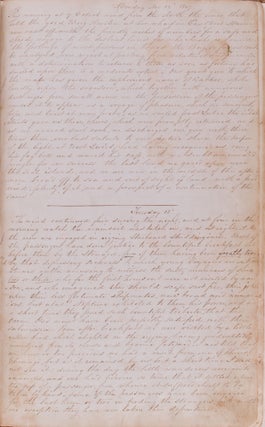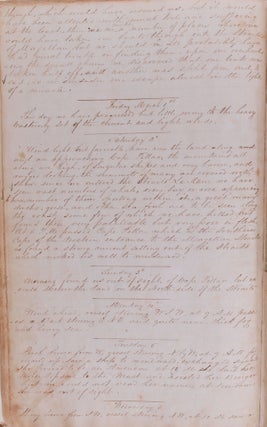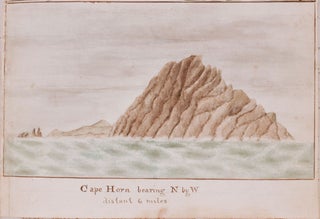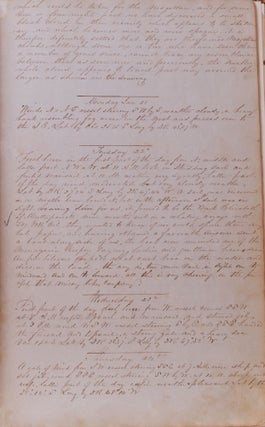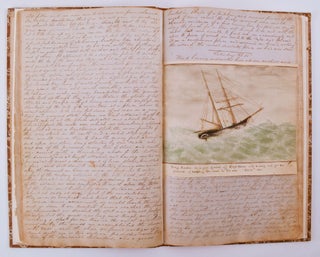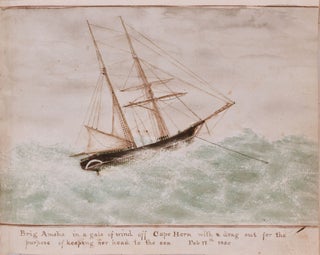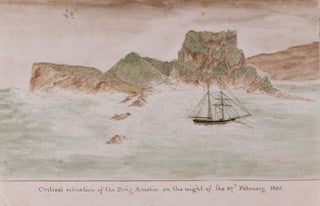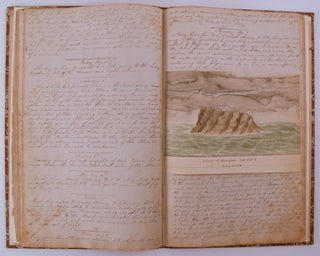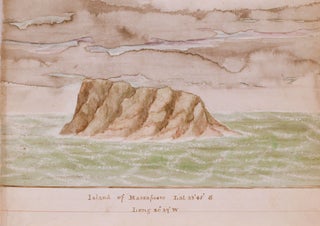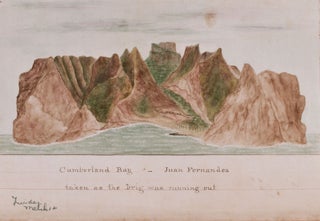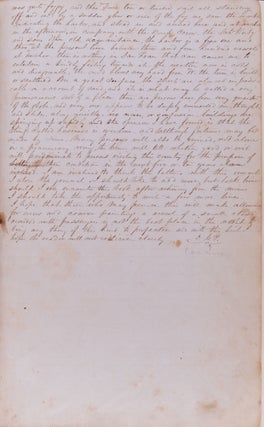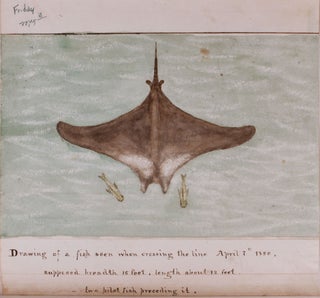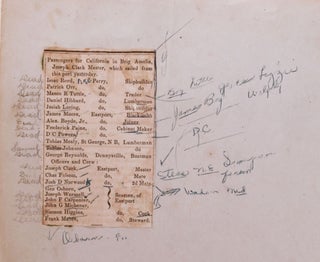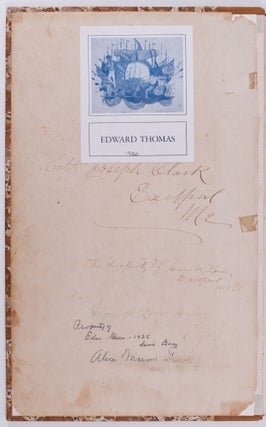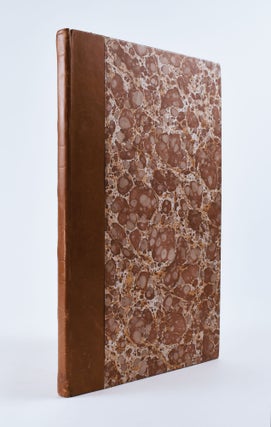Journal of a Voyage from Eastport ME to San Francisco UC in the Herm Brig Amelia. Captain Joseph Clark : Mate Charles Folsom : 2d J.D. Norwood.
Aboard the Amelia, 12 Nov. 1849–3 May 1850. Folio (3.375” x 8.5”), later half brown calf and marble paper over boards, original preliminary leaf preserved and applied as front paste-down. Title leaf, 6 pp. “abstract” (4 pp. relating to this voyage), with daily bearings, wind readings, and brief notes, taken from another volume; 1 blank leaf, 1 blank leaf; 29 pp. in ink, with 6 ink and watercolor illustrations (between approx. 5.5” x 7.25” and 6.25” x 9”, all on slightly larger sheets with ink captions in margins below) tipped in throughout; 1 manuscript map in ink and watercolor entitled “Track Of Brig Amelia Around Cape Horn In 1850” tipped in. Additional blank leaves. Front paste-down bearing Capt. Joseph Clark’s ownership inscription in ink, below which are several generations of later ownership inscriptions in his line, starting with his daughter, “Anna M. [Clark] Lowe”, and followed by “Florence Lowe Green”, “Edna Green”, and “Alice Marion Green.” Bookplate of collector Edward Thomas, dated 1980 affixed above Clark’s name. Pasted to verso of title leaf is a newspaper clipping, evidently published in Eastport at the time of the Amelia’s departure, listing the crew and passengers, with contemporary and later annotations in ink and pencil. Later marginal checkmarks in blue ink indicating passages of interest; 3 illustrations with later marginal annotation in same ink. CONDITION: Very good, page extremities worn and slightly chipped, some toning and light soiling to lower right corners of many pages. A delightfully illustrated and engagingly written journal recording a seven month voyage from Eastport, Maine around Cape Horn to San Francisco, including several brief but interesting stops in the southern hemisphere, a severe storm that nearly destroyed the ship, and a rather skeptical first impression of San Francisco, with a meticulous ink and watercolor map of the brig’s course around the Horn and six attractive and ink and watercolor drawings, two of them quite dramatic. This journal commences with the Amelia’s departure from Eastport Maine, with accounts of “the friendly wishes of numbers for a safe and speedy voyage” her passengers received at the Eastport wharf, at Lubec, and at West Quoddy Light, as well as “the last land we gazed upon.” By November 14th the party reaches the edge of the Gulf Stream (where “numbers of porpoise are playing around the Brig, and the passengers are forward witnessing their gambols, and speculating upon the inhabitants of the vasty deep”), and excepting a week or so of “ugly sea” (“passengers low spirited, some of them longing for mince and custard pies”). They find themselves “bombing merrily along,” crossing the equator on December 30th, sailing past the Roca Islands on January 2nd, and reaching the coast of Brazil on January 4th, “at a place called the Point of Pipa” (which “resembles that of Long Island as seen when running through the sound, it is quite sandy and the vegetation is sparse, there are many little clusters of miserable huts along the coast reminding one of the abodes of our southern slaves although hardly as good”). En route they observe porpoises, dolphins, grampuses (orcas), and flying fish, and catch an albatross; speak other vessels, many of which are also San Francisco bound; and find themselves, in mid-December, “covered with a substance resembling paint, called spanish brown” (“I have endeavored to account for this phenomenon by supposing that they have been visited on the coast of Africa (from which we are not far distant) by a Simoon”. On New Year’s Day, the author feels he is alone in his skepticism as to whether “the beginning of another year will find them in most prosperous circumstances.” On February 9th they glimpse “the land of Terra Del Fuego [sic],” which “presented the appearance of a vast range of mountains,” and make good time around the Cape of San Diego, stopping to explore in Good Success Bay (where “we carved our names upon the rocks, and erected a tablet on which was recorded the day of our having sailed from Eastport, the day of our arrival in the bay, and the place of destination”). During this period they encounter several more vessels, one of which, “in answer to our inquiry of where they were bound…said they were bound to the same place that every other person was, [but] not knowing whether the individual who answered our hail was of a religious frame of mind, and if so what his particular belief was, or whether he spoke in a worldly manner, we remained unsatisfied as to his destination, although we gave him three cheers which he returned.” Their passage around Cape Horn begins with deceptive ease—the first illustration of the volume shows “Cape Horn bearing N by W distant 6 miles” over a calm sea—but their ensuing adventures are detailed over several pages: Thursday [14 Feb.]…at 11 AM passed the Cape within half a mile at fair wind, having been favored with decent weather…and knowing the bad reputation of the Cape, and considering ourselves beyond its reach, we hoisted up our swivel and having loaded it and put a grape shot in, we fired it off full in the face of the Cape, but alas! We had begun too soon to manifest our contempt for the hoary weather beaten veteran, one hour after or at 12 [P]M we were struck with a heavy squall from SW, attended with hail and rain, it appeared that we had aroused the old fellow and we were now to receive our punishment… Taking shelter on the west side of the island lest they be blown out to sea, the group then disembarks and climbs to the summit of Cape Horn: we clambered up the side of the mountain at a place where the ascent appeared to be easy, but some of us were in a very tired and nervous state before we had attained half the height, which at the place selected was about three hundred feet, the rocks over which we clambered appeared safe, but it was a treacherous spot, the mere points of them were stuck in the earth, and a solid step upon them would cause them to tremble many feet around us and upon one stone being started by our mate who was one of the pioneers, many tons of stone and earth were carried with a thundering noise to the bottom…the summit of the mountain was at length attained, and having rested we proceeded to erect a monument of loose stones, kindled a fire, and sat down to meditate, having remained upon the summit an hour or more, we prepared to return. A part of the company returned by the old track, whilst others selected a safer one… They remain anchored at Cape Horn until February 16th, but after leaving make very little progress: “most of what we have gained one day we generally lost the next.” The storms escalate on February 27th, when violent gales “entangled the peak of the mainsail with the rigging in such a manner that it was impossible for a time to get the sail under control,” and they are forced into dangerous proximity to “the chain of rocks” around Landfall Island. Over the course of the afternoon “the squalls increased in number and violence” and near midnight the large chain parted, and the general opinion was that the good brig would cease to exist, or at best that she would be an unshapely mass—the crew forward had been engaged for some time past in packing their most valuable dunnage, whilst the passengers were selecting and bestowing about their persons some few articles they most prized, the officers of the brig had done all that could be done for her safety, and men were anxiously awaiting the parting of the small chain…until half past three in the morning the squalls continued the same in violence, but did not bring so heavy a strain upon the cables; they were of a kind peculiar to this region, appearing at one time to come with like violence from all points of the compass, and again as though they were discharged from aloft directly down upon the deck of the vessel, one being unable to stand erect under them. At half past three a squall more severe than any we had yet experienced struck us, and from the noise on deck we imagined the vessel had started, but it was not destined to be so, the squall struck her partly on her side and passed off without having done any mischief—immediately after this the wind hauled more to the west and became moderate, and after a heavy fall of rain the weather was passably good, we swept for the anchor but were unsuccessful, and at 9 AM got underweigh and stood to sea with feelings greatly relieved—the danger we had escaped was imminent, we were so near the ledges that there was not the least possibility of our escaping from them by making sail had our small chain parted…upon our overhauling the small chain we discovered that one link was broken half off, and another was split from end to end, so we consider our escape almost in the light of a miracle. An illustration of this “Critical Situation for the Brig Amelia on the night of the 27th February 1850” is tipped in at this entry, showing her perilous proximity to “a number of rocks of large size some of them sunken,” in the shadow of the “mountain composed of large jagged rocks” which was their only protection from “a heavy sea.” A page earlier, tipped in above the corresponding entry, another dramatic illustration shows the “Brig Amelia in a gale of wind off Cape Horn with a drag out for the purpose of keeping her head to the sea Feb 17th 1850.” The rest of their voyage is relatively smooth: they pass Massafuero Island (now Alexander Selkirk Island, the illustration of which is tipped in above the first page of the March 12th entry), and reach Juan Fernandez Island on March 14th, where they enjoy fresh fruit, meet a Yankee who “had been residing on Juan and Massafuero for the last three years,” and encounter two other vessels also bound for California, from which they learn of troubles aboard other ships, including ill health, suicide, and even a murderous doctor who had to be “put in irons for attempting to poison some on board.” A picture of “Cumberland Bay – Juan Fernandez : taken as the brig was running out” is tipped into the middle of the March 12th entry, which covers several days. On March 21st they cross the Tropic of Capricorn, where they exchange news with “the brig George Shattuck of NY from Boston, the same brig we spoke on the 26th Nov 1849, they stated that they had been in Talcahuano for supplies and had left forty sail of vessels in the harbor bound to California, they also stated that there had been a heavy fire in San Francisco and that there was much sickness, we sailed side by side an hour or more.” On April 7th they cross the equator, and are followed by a “devil fish” (also known as a giant devil ray) which they estimate to be fifteen feet wide and twelve long, flanked by two “diamond fish,” which they imagine to be “officiating as pilots” (the subjects of the last and rather marvelous illustration). On May 6th they arrive in San Francisco Bay, where “there are at the present time between three and four hundred vessels at anchor.” The final entry of the volume provides an evocative, though pessimistic, account of the burgeoning city: there is nothing in San Fran that can cause one to entertain a kindly feeling towards it, the weather now is cold and disagreeable, the wind blows very hard from W. the town is built or scattered over a great surface, the street are almost impassable on account of sand, and it is what may be called a very promiscuous sort of a place. There are persons here from every quarter of the globe, and every one appears to be deeply immersed in thought and slides along quietly, no noise or confusion, buildings are springing up rapidly and the opinion I have formed is that the thing called business is overdone and although fortunes may be made by some, many persons will also be ruined, not alone in a pecuniary way, the time will tell whether good or evil will predominate to persons visiting this country for the purpose of bettering their condition in the next five or ten years. I am inclined to the think the latter. This entry is signed “D C P”, indicating that it was written by one of the Amelia’s passengers, one “D. C. Powers,” whose name is listed in the newspaper clipping pasted onto the verso of the title leaf. Since the hand is consistent throughout, we ascribe the entire journal to Powers, who apparently gave it to Captain Clark. The map and illustrations provide a significant visual dimension infrequently found in journals of gold rush voyages. The map, meticulously detailing the “Track of Brig Amelia Around Cape Horn,” is particularly skillful and clearly not the first drawn by its author. It shows the tip of South America, including lower Patagonia, Tierra Del Fuego, etc., and includes a multitude of names for land masses, bays, straits and so on. The track of the Amelia is shown beginning with its approach to the vicinity of the Strait of Magellan and ending just west of Madre de Dios. Dated positions of the ship are shown throughout, extending from Feb. 6th to March 4th. As the map and illustrations are tipped in and none are signed, it is unclear whether they are the work of Powers or someone else on board. SOME REPRESENTATIVE PASSAGES: 12 Nov. 1849: “This morning at 9 Oclock wind from the North, the lines that held the good Brig Amelia at her wharf in Eastport Maine were cast off, with the friendly wishes of numbers for a safe and speedy voyage to the distant land for which she is bound. The feelings of most persons on board the Brig, so far as could be analyzed, were regret at parting from relatives and friends, with a determination to return to them as soon as fortune had smiled upon them to a moderate extent. Our great gun to which the mate has given the euphonious name of Barker spoke loudly, upon the occasion, which together with numerous discharges from small arms in the possession of the passengers caused it to appear as a voyage of pleasure, which we sincerely hope and trust it may prove, as we sailed past Lubec the inhabitants gave us three cheers which were promptly returned, and as we neared sail rock, we discharged our gun with three times three, our last salute to our native shore. The keeper of the light at West Quoddy head having recognized us, rang his fog bell and waved his cap, with no doubt an inward prayer for our success. The last land we gazed upon were the seal islands, and we are now in the middle of the afternoon broad off to sea and out of sight of land, with a fair wind, plenty of it, and a prospect of a continuation of the same.” 13 Nov. 1849: “Most of the passengers have done justice to the bountiful breakfast set before them by the Steward, few of them having been greatly troubled by that depressing sickness to which young voyagers are subject. It was rather amusing to witness the salty manners of some two or three, who for the first hours out were not visited by nausea, and who imagined they should escape scot free, their jokes upon their less fortunate shipmakes were broad and numerous, but alas! Neptune exhibited to them his power, and in a short time they paid such bountiful tribute that the Ocean God must have been perfectly satisfied with their submission. Soon after breakfast we were visited by a little yellow bird, which alighted in the rigging, having undoubtedly wandered from its course and become fatigued.…during the day the little wanderers were quite numerous, and one had become so tame that it settled upon the cap of a passenger, from whence it suffered itself to be taken by hand, some of the passengers have been engaged for the last hour or two in feeding the strangers, and with one exception they have now taken their departure.” 16 Nov. 1849: “Awoke this morning with every bone in my body sore…the Brig has been bobbing about in such a manner that one could not lie still an instant, one sea catching her under the quarter, and another forward, causing her to trip, we have foresail, foretopsail, and mainsail again upon her, and a strong breeze from NNE…at PM added main staysail, and she plunging through the water and frightening the flying fish in her course, to the great delight of the fresh water gentlemen on board.” 26 Nov. 1849: “…passengers this morning are shooting at grampus along side. At 8 AM we neared the vessel supposed to be the schooner spoken of, and found it to be a full rigged Brig bound to San Francisco…upon learning where she was bound, we gave her three cheers which were returned by the crew, and some half dozen passengers, we then up topsail [sic] and parted company.” 4 Dec. 1849: “Wind NE by E, vessel steering SE course, at six bells the ship above mentioned being quite near, hove to until we came up, she proved to be the Sartelle 18 days out from N York, and bound to San Francisco…she appears to be deeply laden but supposed to have very few passengers as few persons were seen, upon learning that she was bound to San Francisco we gave her three cheers which were returned, one of the persons on board ship was extremely anxious to know if we had any of the feminine gender on board, and upon our answering that we had nothing but a pig, stated they were in the same situation, suppose from our own feelings that he must be quite disconsolate as we have been lamenting our lot for some time past.…At 6 PM they fired a big gun on board the ship and gave us three cheers, which was returned by a discharge from Barker and three cheers from all hands, after which some of the passengers joined in a dance at a tune from the violin and octave flute and the evening passed pleasantly.” 15 Dec. 1849: “One of the vessels standing SW a barque, has been steering in a singular manner, a portion of the time standing on a wind, and again running off before it, we concluded they were having a jollification on board.” 16 Dec. 1849: “A very good chicken soup to day at dinner, consider I am bound to record it as it is first of the kind.” 19 Dec. 1849: “…the atmosphere has been very dense since yesterday morning, this morning we were surprised on looking aloft, to discover our topmast staysails covered with a substance resembling a paint, called spanish brown, during the day it continued to spread over the other light sails, and the rigging, and in fact every thing that presented a broomy surface, the water a short distance from the brig had the appearance of having been colored, the air too is very impure, and very oppressive, most persons on board complaining of sore throats and eyes, I have endeavored to account for this phenomenon by supposing that they have been visited on the coast of Africa (from which we are not far distant) by a Simoon, and as the wind is blowing strong off the coast, the light particles have reached and in fact extend far to the leeward of us, the heavy particles having fallen into the sea between us and the main land, the red powder which can be scaped from the sails, and of which I have preserved a small quantity, has the taste of copper, and is almost wholly free of grit, the sun has endeavored to shine but was unable to present a more luminous or brilliant appearance than an old tin pan, in fact the general appearance of things is quite singular, or in yankee parlance very queer.” 1 Jan. 1850: “…wished our absent friends happy New Year, and while recording the same, take the library to record with a solemn observation, that there never was a cruise made of one tenth the length, that was not more productive of interest than our cruise thus far, it may be expected that at the commencement of a New Year, and bound on a voyage of this length, with the uncertainty of a continuation of health, or of bettering our worldly condition, that most persons on board would have felt in the spirit of meditation, but these things which cause many to reflect and generally depress the spirits seem to have an entirely different effect upon our passengers and crew, their feelings seem more buoyant than usual, and they are sanguine that the beginning of another year will find them in most prosperous circumstances.” 7 Jan. 1850: “Many persons on board are carried away by what they term the extraordinary beauty of the coast, but viewing it under the most favorable circumstances, longing after something to relieve the monotony of a two months trip at sea, together with a knowledge that the land we look upon produces the most delicious fruits, and is rich in more respects than one, I say under all these favorable circumstances, I cannot with truth record it as any thing more than a very ordinary coast as seen from the deck of our vessel.” 22 Jan. 1850: “…late in the afternoon another sail was in sight, bearing down for us, it proved to be the Bark Elizabeth of Mattapoiset [MA] nine months out on a whaling voyage with 500 bbls Oil, they wanted to know if we could spare them any late papers, and having obtained a favorable answer sent a boat alongside of us, the boats crew reminded me of the Menagerie Keeper, saying, ladies and gentlemen hese’ [sic] some Amphibious bipeds what cant live on the water and dies on the land. The cry is, two more sail in sight, one to windward and one to leeward, all this is very cheering on the principle that misery likes company.” 10 Feb. 1850, Good Success Bay: “the bay is formed by large mountains, whose peaks run into the clouds as an elevation of twelve to fifteen hundred feet above the level of the sea, they are quite precipitous and from the deck of the vessel presented the appearance of being covered with a stunted kind of shrubbery, another proof of the old saying that appearances are quite deceitful, for upon getting ashore we found the mountains heavily timbered, one tree which we girted measured about eighteen feet in circumference, many of them were one hundred feet in height, the soil was very rich and deep, vegetation very rank, an abundance of flowers and berries, one shrub bearing a berry very like the marsh cranberry, the rocks which line the shore are massive, and cavities of great depth are worn in them by the surf. One measured ran one hundred and sixty feet in the mountain in a straight line, when it took an upward direction how much further we could not tell…we carved our names upon the rocks, and erected a tablet on which was recorded the day of our having sailed from Eastport, the day of our arrival in the bay, and the place of destination. We then went on board and set sail, bidding adieu to Good Success Bay with kindly feelings towards it for everything but our reception on shore, which was rather cool, being nothing more nor less than the capsize of our boats in the surf when first visiting the shore, and giving us a confounded ducking.” 14 March 1850, Juan Fernandez: “We endeavored to peer through the darkness and ascertain the kind of place at which we had arrived, we could discover high land surrounding us and so high that it did not permit the glimmer of a star to shine down upon us, our ears too were saluted with all manner of noises, the braying od asses, barking of dogs, neighing of horses etc etc soon after coming to anchor we were visited by several persons from the brig before mentioned, they gave us as news that the island had bee vacated by the troops and families that formerly had possession of it, that some few persons since that time had settled upon it for the purpose of cutting wood to supply vessels, and catching the fur seal (which are numerous) the skins of which they sell to trading vessels or ships to some port on the main, they stated that we would not be able to obtain any supplies from the island, other than wood and water, but that we could get any quantity of peaches and quinces with but the trouble of gathering. The brig was the Galen of New Bedford 155 days out and bound to California with several passengers, they had suffered much from bad provisions and the leaking of the brig, which was so bad as to keep them most of the time at the pumps, they had lost one of their passengers by his having jumped overboard in a fit of derangement, he had become quite melancholy soon after leaving the US and endeavored to commit suicide by cutting his throat, being frustrated in this he took advantage of an opportunity that offered, and went overboard, they stated that nearly every vessel that had rounded the Horn had lost one or more by sickness and that on board the Orion there had been much difficulty among the passengers, the Doct of the Orion having been put in irons for attempting to poison some on board. … We found there were twelve residents upon the island, two of them were Chilians with their families, whilst the others were persons who had been left there at their own request from whale ships, they were all of the vagrant order. We were surprised to find a Yankee as one of the oldest residents on the island, he was from Whiting, Maine, and had been residing on Juan and Massafuero for the last three years, nine months of the time was passed upon Massafuero, the remainder upon Juan Fernandez, he had been quite unfortunate, according to his story…” A remarkable journal of a gold rush voyage, especially compelling for its uncommon visual content.
Item #8100
Sold


